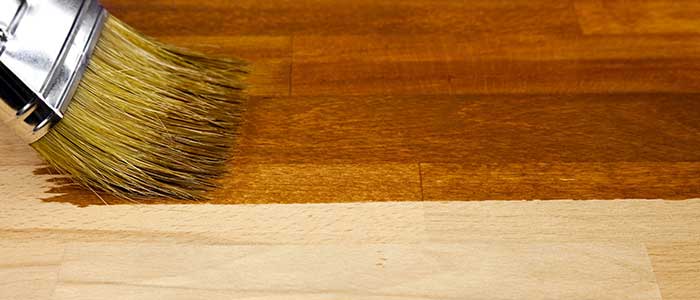Nowadays, it is impossible to think of a wooden floor without the elegant high gloss lacquer finish or the more modern and edgier matte finish, or anything in between really. In fact, wood floor finishes have become such an important part of owning a wooden floor that no one even bothers to purchase an unfinished wood floor and later deal with the whole sanding and finishing process, even though this second option allows for creative customisation. However, it wasn’t like this back in the days. Let’s explore more about the history of wood floor finishes and how they get so popular.
Despite the fact that hardwood flooring dates back as early as the beginning of the seventeenth century, wood floor finishes were not used until late in the nineteenth century and they gained more popularity just recently. In the beginning, finished hardwood floors were mainly installed in public kitchens and bathrooms. It was considered that the finished wood flooring options are more hygienic and easier to maintain and keep clean. However, slowly but surely, the finished wood floorboards began gaining more and more popularity in residential homes too.
In the Victorian era, when wood floor finished first appeared to be used more widely, they were a mix of natural ingredients, similar to the modern shellac and wax finishes nowadays. These finishes were applied and used for achieving a better, more attractive look on the wooden floor, making the floorboards appear shiny and new. The finishes were applied right after the fitting of the floorboards.
However, prefinished wooden floorboards, which means the floorboards are leaving the factory with a finish already applied to them, appeared as a byproduct of the Second World War military production. It all started with the US manufacturers who produced boats for the Navy from oak plywood. They were looking for ways to utilize all the wooden scraps, so they came up with the idea of cutting the scraps into boards and finishing them with a protective wax coat to preserve them. Next, these wax-finished wood blocks were installed in houses and here is how the first factory-finished or prefinished wood flooring was born.
After the end of the Second World War, more and more manufacturers started producing and selling prefinished wooden floorboards. By the end of the fifties, polyurethane finishes emerged on the market and thanks to it, the market of prefinished wood flooring pretty much experienced its highest peak at the moment, getting a lot of popularity and attention. Thanks to technological advancement, progress, and innovations in the industry, the market is still enjoying amazing popularity all around the world.
The sixties introduced a new generation of synthetic resins used for finishing real wood floors. It was also the time of the first wave of innovational, extremely durable and long-lasting polyurethane and varnishes and finishes. By that time, wood floor specialists used a popular back then method of two passes, which included a first layer of finishing with the added colour to the finishing product for creating a colour of choice, while the second layer consisted of the topcoat and guaranteed impressive durability and great protection. Next, finishing products were cured with heat from infrared ovens or a combination of steam and hot air dryers.
The seventies were the decade of the introduction of oil-based wood floor finishes. The decade was also marked by direct-to-consumer sales. It was a time when classic parquet floor patterns made their huge comeback since their first appearance at the beginning of the seventeenth century. By this time, manufacturers started producing and offering prefinished wooden floorboards and floor blocks that were now directly sold in showrooms and wood flooring stores and that could be purchased by anyone. It was the time when DIY-ers experienced wood floor installation more often and the time when professional wood floor installation contractors were highly sought after. Wax finishes remained popular during the decade, however, the market was strongly dominated by glossy oil-based finishes with an added colour.
By the beginning of the eighties, wood floor finishes were still cured with heat, however, this started to change by the middle of the decade when the old method was widely replaced by UV-cured urethanes, which are still used nowadays. The launching of this new and innovative system made a significant change in the industry and impacted the manufacturing process.
With a faster production process and reduced space required for producing prefinished wood flooring, the manufacturing industry witnessed a significant rise. During the nineties, regulations around the world were already started getting stricter regarding solvent-based materials and products. As a result, manufacturers started developing a system for replacing solvent-based products with waterborne wood floor finishing products. The first finishes with sealer coats were introduced on the market during this decade in order to meet the growing demand for improved durability and more lasting power. These innovative finishes include aluminium oxide as an ingredient. Since these wood floor finishes offered even better wear resistance, their popularity quickly rose among customers and clients.
The new century put more emphasis on durability and eco-friendly products in the context of wood flooring products and finishes. Low VOC materials and products were the most sought after on the market and still are to this date. UV-cured products continue to dominate the market nowadays as an alternative for more eco-friendly production of prefinished wooden floors. The future of UV-cured wood floor finishes and products seems bright as long as a stronger emphasis is put on appearance and aesthetics too.
Soon customers will not only look for durability only as the main focus will also shift towards durable finishes that offer the same aesthetics and beauty as oil-based and wax finishes. Sustainability will also be a huge factor impacting the market and production of wood floor finishes. As a result, the demand for more sustainable products that offer low environmental impact will increase significantly.

Be the first to comment on this post.